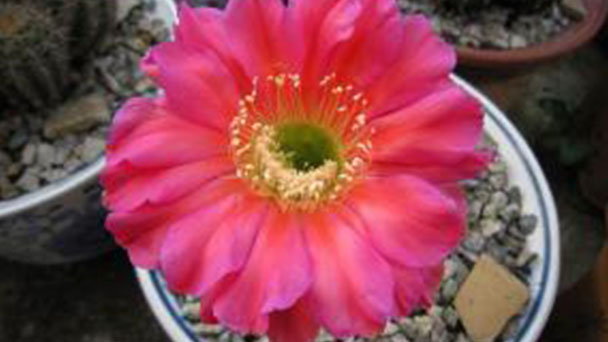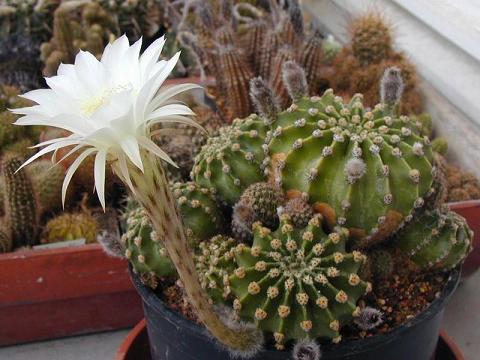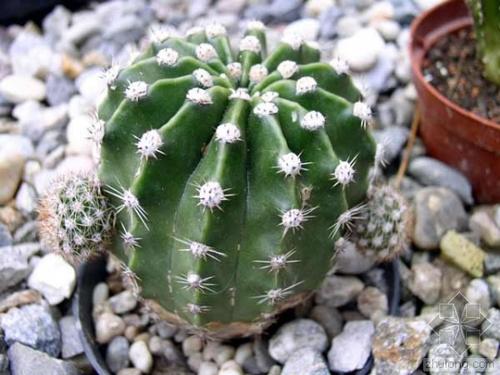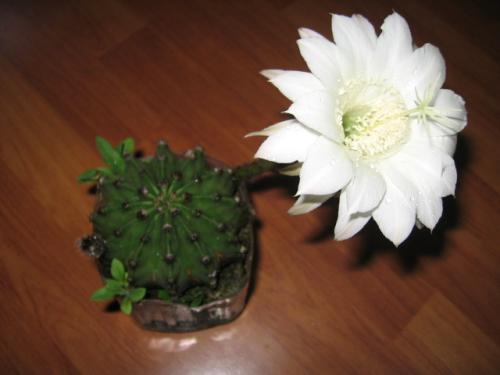Echinopsis eyriesii profile
Written by Maggie
Oct 14 2021

Echinopsis eyriesii is the most common species in the genus Cactus. Echinopsis eyriesii is the most common species of the genus Cactus. Echinopsis eyriesii is native to South America, usually growing in hot, dry desert areas with little rain. It is dry and drought-tolerant. The main growing season of cactus is summer, which is also its flowering period.
Echinopsis eyriesii is a strong vitality, as long as the control of watering, winter indoors, generally will not die. The ball is very long, just break one off and put it on the soil to survive. Although common, echinopsis eyriesii is found in high numbers among plant lovers.
Echinopsis eyriesii picture

Echinopsis eyriesii characteristics
Echinopsis eyriesii is about 30cm high, with 11 to 18 angles, short spines, dark brown. Flared, white, open at night. The young plants of Echinopsis eyriesii are solitary, the old plants are easily clustered, spherical to cylindrical, and the body color is cyan green. Ball is 12 -- 15 cm in diameter, 20 -- 25 cm in height, with straight edges 11 -- 13 ridges high. Light brown short spines 10-14 conical. Flowers: Late summer and early autumn side white funnel-shaped flowers, open Echinopsis eyriesii sphere is green, cylindrically shaped, the edges are neatly arranged, and the spines are grayish-brown. Summer is the flowering period, the small bud day by day bigger and longer, until the last like an oversize writing brush.Flowering time is not long, from 6 or 7 PM to open to the next day at noon. The flower shape is larger, white simple but elegant, and sends out the faint fragrance that smells very well, this is not seen much in other cactus. Standing proudly, there is a taste of standing out from the crowd, which is why it is known as the "Queen of the Night" in Europe and the United States.
Echinopsis eyriesii native habits
Echinopsis eyriesii is fond of warm and sunny environments, drought resistant but not cold resistant. They require shade in summer and sufficient sunshine in winter. The suitable temperature is 18 ~ 30℃. Echinopsis eyriesii is suitable to grow in loose, fertile sandy loam.
Echinopsis eyriesii distribution
Echinopsis eyriesii is originally produced in tropical South America, especially in Brazil, Uruguay, widely distributed, and many countries in the world are cultivated.
Echinopsis eyriesii uses
Set up a tropical desert landscape in an exhibition greenhouse in a botanical garden or park. Echinopsis eyriesii also can be potted ornamental.
Echinopsis eyriesii propagation
Beheadings propagation
You can cut off the head of the Echinopsis eyriesii using clean scissors. Leave a few inches to the base to stay on the safe side. There should be enough stem on the cutting. Before replanting, wait for a few days so cutting and the base can dry. When the cutting is calloused, replant it. Don't forget to water when the soil dries out.
Sowing propagation
Echinopsis eyriesii is a slow grower so even if it can be propagated by its seeds, this method is not recommended. To propagate from the seeds, plant the seeds in a well-draining soil mixture. This method can be used outdoors. In cooler areas, indoor propagating is recommended.

Where to grow Echinopsis Eyriesii
Echinopsis Eyriesii need strong light. When planting this succulent type in a garden, make sure it gets sunlight. Full to partial sun is the best for its growth. It is better to grow outdoors rather than indoor.
Echinopsis Eyriesii prefers a warm climate. It can survive in a zone native to the cactus. If you live in a cold area, it is better to plant your cacti in an indoor environment. As long as it gets enough sunlight, the plant will grow happily.
When selecting what pot to use be sure that you understand the difference between the material used.
Echinopsis Eyriesii care
Echinopsis eyriesii is strong and easy to grow. The basin soil can be made up of three parts of humus soil, garden soil and coarse sand, and one part of culture soil mixed with plant ash and old wall ash. The flowerpot should not be too large, so as to accommodate the ball and a slight gap as well, otherwise, the ball small basin is large and empty and affects beautifully.
When going up the basin, the basin bottom is cushioned on a broken tile or coarse coal cinder, facilitating drainage. The planting depth should be equal to the soil surface. Just planted Echinopsis eyriesii do not water, water 2 ~ 3 times a day, half a month can be poured a small amount of water, 1 month long after the new roots can gradually increase the amount of water. Watering to master the principle of "see dry see wet", such as basin soil surface dry water, water to be appropriate, by all means avoid basin water. After watering to loosen the soil in time, in order to keep the soil loose and breathable. Water supply should be more moderate during flowering. Overwintering period should be strictly controlled watering, keeping basin soil not too dry.
Echinopsis eyriesii grafted with a three-pruned arrow can be fertilized with decayed thin cake water every 15 to 20 days during the growing season. Other types of Echinopsis Eyriesii are usually treated with small amounts of liquid fertilizer in the seedling stage and small amounts of phosphate in the adult stage. If the water is large and fat, it is easy to cause the bulbous growth into deformity, bristles become short, not easy to blossom.
Echinopsis eyriesii should be replanted every 1 to 2 years in early spring. Cut off part of the old roots and remove part of the old soil when changing the pot, air it 1 ~ 2 days later and then put it on again, and add some new culture soil.After changing the basin, should not water immediately and insulate, want to be put in shade place conserve, water again after 1 week, this is conducive to growth. In spring, Echinopsis eyriesii is put outside to the sun for maintenance after warm weather. In summer, it is necessary to pay attention to proper shading and good ventilation. In case of rain to move into the room in time, so as not to be rain after the basin caused by water and Echinopsis eyriesii retting root death. If you have been caught in the rain, loosen the soil immediately to accelerate the evaporation rate. In early autumn, cold areas in northern China can be safely wintered by moving to a sunny place indoors and keeping the room temperature above 5℃.

Latest Updated
- Benefits of Bugleweed - 7 Science-backed Health Benefits
- Bugleweed Dangers & Side Effects - Is It Poisonous?
- How to Plant Evergreen Trees - What You Should Know
- When to Plant Evergreens - Grow Guide for Evergreen Trees
- 12 Wonderful Evergreen Shrubs for Your Garden
- 12 Popular Evergreen Plants with Pictures for Beginners
- When And How To Prune A Lilac Bush Like a Pro
- How to Grow & Care for Lilac Vine (Hardenbergia Violacea)
- Japanese Lilac Tree (Syringa Reticulata) Care & Propagation Guide
- Shumard Oak Pros and Cons - What to Know
Popular Articles
- Winter maintenance of Antirrhinum Majus
- How to Grow Terminalia Mantaly Tree
- How to Grow and Care for Crossostephium Chinense
- How to grow Antirrhinum Majus in spring
- Peristeria Elata (Dove Orchid) Profile: Info & Care Guide
- Underwatered Snake Plant (Sansevieria Trifasciata) - Signs And How To Fix
- How to Care for Brazilian Jasmine Plant (Mandevilla Sanderi)
- How to Grow & Care for Graptopetalum Purple Delight in Summer
- Rosa Chinensis (China Rose): Plant Growing & Care Tips
- How to Care for Baby Sun Rose (Aptenia Cordifolia)